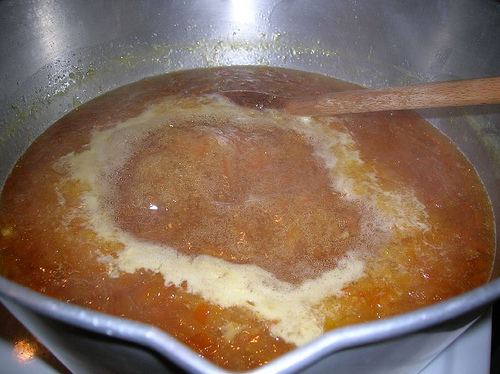Tis the season to make marmalade, well British style marmalade to be precise. The bitter Seville orange makes its appearance very briefly in January and rolling on into February. Marmalade makers eagerly seek out the rough skinned Seville for its very tart flavor to make the clear jelly with citrus peel suspended through it.
These bitter oranges originated in Asia and were taken across to Europe by the Romans where they flourished. Legend has it that a ship carrying a consignment of these oranges was taking shelter from a storm in the Scottish harbor of Dundee, when a young grocer named James Keiller offered to buy the oranges. They may have been cheap but they were also unsalable owing to their sour taste. Fortunately, his wife came to his rescue and cooked them with sugar before putting the preserve into jars to go on sale in the shop where they soon sold out. A regular order was placed to Spain by the Keillers and by 1797 they opened up Britain’s first marmalade facto

Today Seville still exports their oranges mainly to Britain for marmalade making as the Spanish can pick them freely from the trees but have little taste for them. Although a local convent does make cinnamon flavored syrup from these bitter oranges which are served with their pastries and there is also a local dish called bacalao en naranja agria (salt cod with bitter orange juice).
In France the classic bigarade sauce served with duck is made from bitter oranges and port, as normal oranges would be far too sweet. Bigarade being the Provencal word for bitter orange. Seville orange juice could also be added to oil to make a zingy salad dressing or pieces of dried peel could be dropped into a bottle of vinegar to impart its tangy flavor over a period of time. The juice can also be used in place of lemon juice to make an interesting take on the Latin American dish of ceviche whereby the citric acid ‘cooks’ the fish. Seville orange juice also works well in cakes and pastries.

But back to the marmalade, 2lbs of Seville oranges will yield 10 jars. The washed oranges are covered with 4 pints of water and simmered for a couple of hours. The oranges are cut in half and scraped out; the pectin rich pith and pips are wrapped in a muslin cloth. The peel is chopped into strips. The juice, sugar, peel and cloth are added to the water to be boiled for approximately forty minutes and reaching the setting point of 220F. Then it is poured into sterilized jars to be used in many delicious recipes or simply on hot buttered toast. In days gone by the Irish would melt lamb’s caul and pour this fat over the marmalade to prevent mould but they could have simply used a little wax paper disc.
Photos courtesy of flickr - musicpb, chicbee04, realbastovan, christine spinks